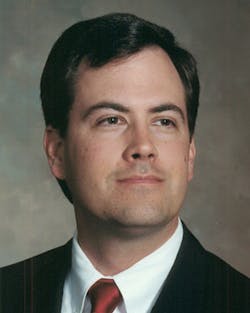Associate vice president, technology and standards at the Telecommunications Industry Association (TIA; www.tiaonline.org), Herbert V. Congdon II now is employed as an executive in the organization that produced scores of cabling specifications under his volunteer leadership. The TIA administrator post is something of a third career for Congdon, who was a commissioned officer in the United States Navy's nuclear submarine force before holding engineering and market-management positions with the former Siecor (now Corning Cable Systems) and Tyco Electronics (now TE Connectivity). In those Siecor and Tyco roles, Congdon held top volunteer posts including chair, vice chair and secretary within the TIA's TR-42 Telecommunications Cabling Systems Committee (which, come to think of it, also got renamed somewhere along the line, when it went from being the TR-41.8 Subcommittee to gaining full-fledged Committee status). When you have been around as long, and done as much, as Herb Congdon, you've seen more than a few things change. And when you are Herb Congdon, you've been an instrumental part of some of the most significant standard developments in the cabling industry's history.
A prolific technical author and speaker in addition to being a stalwart contributor to standards development, Congdon is as skilled a communicator as one can find in the cabling industry. As such, he does a better job relaying his experiences than anyone else could. "My first exposure to standards was the effort to migrate from ring-striped optical fiber as fibers 11 and 12, to rose and aqua colored fiber," he recalls. "This was a welcome change for the manufacturing process, but took several years to accomplish. A few years later I went to my first TR-41.8.1 meeting where the first person I met was Donna Ballast. As one of the 'fiber minority,' I found in each document, ballot and proposal, an opportunity to educate, debate and build consensus on positions related to optical fiber and cabling systems. Looking back, I can point to several contributions I created and hundreds of ballot comments that were ultimately incorporated into the TIA standards and in many cases also incorporated into international standards."
The invitation to serve as secretary of TR-41.8.1 was the springboard to many years of cabling-standard leadership. "In these roles," Congdon says, "the ongoing challenge remained-to take the collective expertise of the participants and produce useful documents, through consensus, for the entire industry. There has never been a shortage of controversial subjects that made the consensus-building process very complex. Regardless, we produced several documents such as 942 (Data Centers), 862 (Building Automation Systems), 1005 (Industrial), 1179 (Healthcare) and others."
The reorganization of the complete set of standards put out by TR-42 began as a conversation between Congdon and fellow long-time standards-development volunteer Bob Jensen-"over coffee during a BICSI conference," as Congdon recalls. "On a Gaylord napkin, literally, we mapped out an ideal for the entire TR-42 suite of standards and the migration process to get there." Jensen has used a photo of the napkin in some of the presentations he has delivered to the industry. "Through the next four to five years," Congdon continues, "with Bob as vice chair and me as chair, we led the TR-42 Engineering Subcommittees through that migration process."
In his previous volunteer efforts, and now in his professional capacity with TIA, Congdon has always recognized that, "TIA standards are not developed in a vacuum," as he puts it. "But those with the patience, expertise and fortitude to be good participants are few and far between.
"I was very fortunate to have several good influences throughout my career in the industry and especially in standards development," Congdon notes. "The late Marvin Ashby (Siecor) offered solid advice early in my career and was a great friend too. John Siemon (Siemon Co.) set an excellent example of how to lead a committee, and how to do so when the controversy was almost uncontrollable. Bob Jensen (Fluke Networks) taught me the rules and how to take the right things seriously, but not all things too seriously. Beyond these mentors, there are too many experts to name that I consider friends, that taught me so much of what I know, and did the lion's share of the work in the committees. These are the unsung heroes of standards development-the men and women who have a full-time job, but still find time (often their own time) to prepare contributions, submit ballot comments, engage in the debate, and support the process ... My thanks go to those in positions of authority who made the decisions to support the standards development process knowing that, while it might not always provide immediate returns for the company, it is good for the industry and that, in turn, is good for the company."
